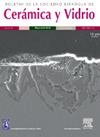通过将简单加工方法的效果与 Nd3+ 和 Nb5+ 共掺杂策略相结合来调节 Bi4Ti3O12 薄膜体系的微观结构
IF 2.7
4区 材料科学
Q1 MATERIALS SCIENCE, CERAMICS
Boletin de la Sociedad Espanola de Ceramica y Vidrio
Pub Date : 2024-11-01
DOI:10.1016/j.bsecv.2024.09.002
引用次数: 0
摘要
由于 Bi4Ti3O12 铁电陶瓷具有奥里维利乌斯晶体结构,因此在获得这种材料时,预计会出现基于板状晶粒的微观结构。这种晶粒形态会导致导电性,使功能响应变得不切实际。在此框架下,我们通过将简单的薄膜获取程序与掺杂策略相结合,解决了导致这种晶粒形态的晶体生长控制问题。一方面,我们采用水溶液-凝胶加旋涂的方法来获得这些薄膜。另一方面,本文在晶格中同时掺入了 Nd3+ 和 Nb5+,分别取代了 Bi3+ 和 Ti4+。通过 X 射线衍射、紫外可见光测量和 FESEM 得出的结果证实,加入的掺杂剂能够阻止(或至少控制)上述晶体生长。本文章由计算机程序翻译,如有差异,请以英文原文为准。
Microstructure modulation of a Bi4Ti3O12 thin film system by combining the effect of a simple processing methodology with a co-doping strategy involving Nd3+ and Nb5+
A microstructure based on plate-like grains is expected in the obtaining of Bi4Ti3O12 ferroelectric ceramics, promoted by the Aurivillius crystalline structure that this material exhibit. This grain morphology would lead to conductivity making the functional response unpractical. In this frame, we address the control of the crystal growth which leads to this grain morphology by combining the effect of a simple thin film obtaining procedure with doping strategies. On the one hand, an aqueous solution-gel plus spin-coating methodology is performed here for the obtaining of these thin films. On the other hand, a simultaneous incorporation of Nd3+ and Nb5+ in the crystal lattice replacing Bi3+ and Ti4+, respectively, is conducted in this contribution. The results obtained by X-ray diffraction, UV–visible measurements and FESEM confirm that the incorporated dopants are able to block (or at least control) the mentioned crystal growth.
求助全文
通过发布文献求助,成功后即可免费获取论文全文。
去求助
来源期刊

Boletin de la Sociedad Espanola de Ceramica y Vidrio
工程技术-材料科学:硅酸盐
CiteScore
5.50
自引率
2.90%
发文量
72
审稿时长
103 days
期刊介绍:
The Journal of the Spanish Ceramic and Glass Society publishes scientific articles and communications describing original research and reviews relating to ceramic materials and glasses. The main interests are on novel generic science and technology establishing the relationships between synthesis, processing microstructure and properties of materials. Papers may deal with ceramics and glasses included in any of the conventional categories: structural, functional, traditional, composites and cultural heritage. The main objective of the Journal of the Spanish Ceramic and Glass Society is to sustain a high standard research quality by means of appropriate reviewing procedures.
 求助内容:
求助内容: 应助结果提醒方式:
应助结果提醒方式:


